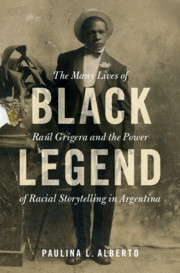Book contents
- Black Legend
- Black Legend
- Copyright page
- Dedication
- Contents
- Figures
- A Note on Terminology
- Introduction Racial Stories
- Chapter 1 Ancestors (1850–1880)
- Chapter 2 Community (1880–1900)
- Chapter 3 Youth (1900–1910)
- Chapter 4 Celebrity (1910–1916)
- Chapter 5 Defamation (1916–1930)
- Chapter 6 Deaths (1930–1955)
- Epilogue Afterlives (1955–Present)
- Acknowledgments
- Afro-Latin America
- Notes
- Bibliography
- Index
Chapter 2 - Community (1880–1900)
Published online by Cambridge University Press: 06 January 2022
- Black Legend
- Black Legend
- Copyright page
- Dedication
- Contents
- Figures
- A Note on Terminology
- Introduction Racial Stories
- Chapter 1 Ancestors (1850–1880)
- Chapter 2 Community (1880–1900)
- Chapter 3 Youth (1900–1910)
- Chapter 4 Celebrity (1910–1916)
- Chapter 5 Defamation (1916–1930)
- Chapter 6 Deaths (1930–1955)
- Epilogue Afterlives (1955–Present)
- Acknowledgments
- Afro-Latin America
- Notes
- Bibliography
- Index
Summary
Later stories about Raúl claimed that his sad destiny was the result of his situation as the only son of a father who died prematurely. In sync with broader racial narratives of Black disappearance, the stories used the trope of orphandom to cast Raúl’s father as the dying Afro-Argentine community and Raúl as its last straggling offshoot. My story, by contrast, zeroes in on Raúl’s father Estanislao, who did not die young; in fact, in the 1880s and 1890s he was at the helm of his own large family in the Grigeras’ ancestral home. Estanislao was a member of the elite or “high life” of the city’s Afrodescendant community. He was a trained pianist, church organist, and classical composer who carried on, but also transformed, his male ancestors’ involvement with candombe into something more refined and acceptable. Although he did not write for the Black press that surged in Buenos Aires in these decades, he appears constantly in its pages in the company of many other Afro-Argentines, famous and unknown. Against the grain of contemporaneous narratives of near complete Black disappearance and later stories about Raúl, “Community” tells a rich story of a Black community at its peak: its newspapers, social organizations, Carnival bands, constant dance parties, courtship and romantic intrigue, and anti-racist activism. Reconstructing Estanislao’s life within this energetic community allows me to imagine the kinds of lessons about politics, masculinity, comportment, fashion, music, and revelry the young Raúl would have absorbed in his parents’ home. I also narrate the strains on this family as they, like their predecessors, struggled with disease, infant mortality, and racism. The chapter’s main theme is the role of elite Black cultural producers and intellectuals, like Raúl’s father, in bringing about the “disappearance” or invisibility of Afro-Argentines through their attempts to conform to cultural norms and avoid racial stereotypes and stories about “buffoonish” or “barbaric” Black people. Estanislao’s generation is key to understanding how the lines of race were redrawn between 1880 and 1900 – at the height of an extremely conservative form of liberalism – to produce a seemingly homogeneous, yet internally stratified, White nation. It was their politics of Black respectability and assimilation, in concert with broader social transformations, that laid the groundwork for Raúl to appear in later stories as a forlorn anomaly. Raúl rejected these politics of respectability, leading to conflict with his father.
Keywords
- Type
- Chapter
- Information
- Black LegendThe Many Lives of Raúl Grigera and the Power of Racial Storytelling in Argentina, pp. 71 - 122Publisher: Cambridge University PressPrint publication year: 2022

